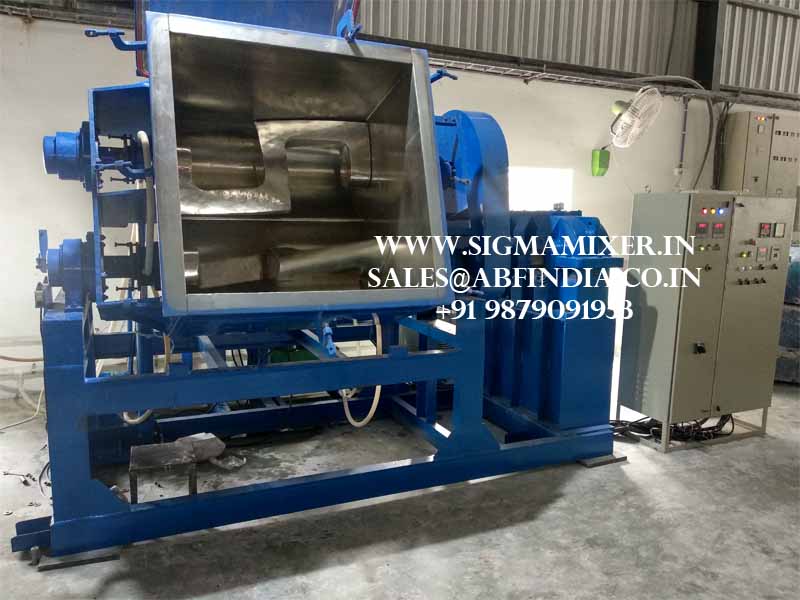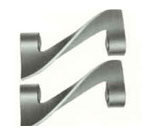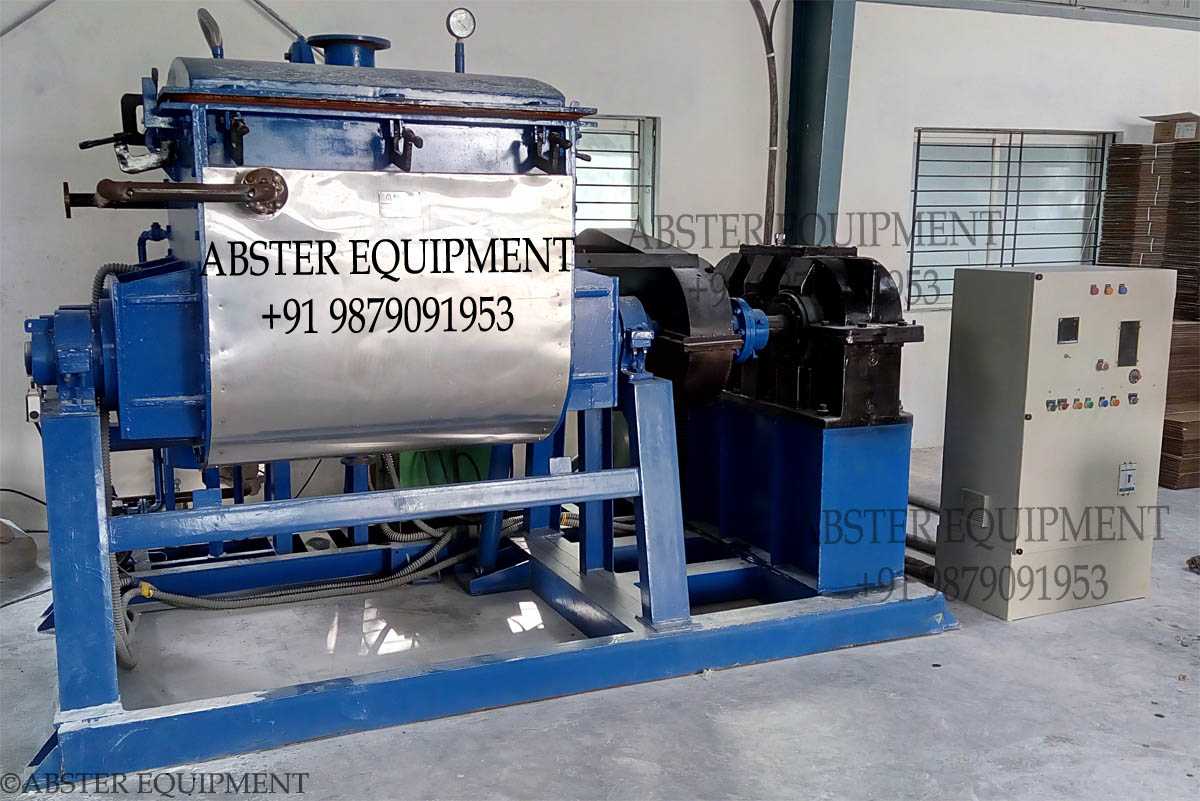
The mixing elements are two nos. Z type steel casted blades.. They contra rotate inward fitted at close or specified clearance with the container to give thorough and uniform mixing. There is a gland pusher of gun metal bush which ensure minimal friction and extend the life of mixing elements (Blades). Two counter rotating mixing arms rotate at different speeds (usually in the ratio of 3 to 2) in the trough, the intersection of which forms a saddle and the arms meet tangentially just above the saddle.
Double Arm Kneader Mixers
The mixing action is a combination of bulk movement, shearing, stretching, folding, dividing, and recombining as the material is pulled and squeezed against blades, saddle, and side walls. Continually new layers of material are compressed and folded over one another and are subjected to shearing forces. New surfaces are formed and the components can penetrate. The blades, which are ground and polished, successively sweep all points of the trough surface during each revolution, at the same time dividing the batch continuously across the saddle piece and thereby achieving a perfect mix.
"DUPLEX" Kneader
Duplex kneaders are twin basin kneaders with two horizontally arranged kneading blades, which are deeply geared into one another and strip themselves reciprocally. The kneading blades are turning to a ratio of 1:2. Because of their different speeds, the blade sides approach and withdraw alternately.
This causes high pressure tensile and shearing rates and therefore heavy friction in the kneading medium, which creates excellent dispersing and homogeneity. The shape of the kneading blades enables a steady flow of material from the side walls of the kneading trough to the middle of the trough.
Apart from the sigma blades, we also offer sigma disperser blades
Different types of Sigma Blade Available
 |
 |
 |
|
Sigma- or Z-form blade
|
Two wing blade
|
Double naben
|
All double arm kneader also called Z arm Sigma mixers are competent of with two mixing blades situated in a W-shaped horizontal furrow. A variety of blade shape have evolved, every of which is best suitable for a scrupulous type of compliance. The frequently use blade types are the spiral blade, masticator blade sigma blade, nabbed blade, and shredder blade. The gyratory motion of the blades is either peripheral to every other or the blades may extend beyond within the furrow. The blades exchange toward each other at the identical or discrepancy speeds. The blades go over the container walls and every one other at close clearances (2-3 mm) resulting in homogenous combination. The secluded clearances assemble of very high shear action thereby sinking any huge particle. These mixers produce a consistent spot size section with no the need for additional high speed chopper. Homogenous mixing is achieved within 10 to 30 minutes. Amalgamation homogeneity up to 99% and improved can be accomplish by means of the double arm kneader mixers. This blender and their difference are capable of usage substance with viscosities as high as 10 million centipoises. The power expenditure in double arm kneader blender is very high compare to other types of mixer and can variety from 45 to 75 KW/m3 of mix substance. The sigma blade mixer is the most frequently used type of double arm kneader mixer, and is finest suitable for all surrounding utilize
Sigma Blade Mixer
In mixers managing very viscous materials, it is essential to support both tangential and oblique motion of the substance. The geometry and profile of the sigma blade is intended such that the glutinous mass of substance is pull, shear, dense, knead, and fold by the exploit of the blade next to the walls of the mixer trough. The amount to which this happen depends on the exploit of the blades - peripheral or overlap and the ratio of the speed of replacement of the blades. The twist angle of the blade can be customized depending on the necessary shearing.
Tangential and Overlapping Blade Action
In the peripheral intend the blades swivel in the trough gathering imaginatively the front blade normally rotate earlier than the back blade more often than not in the ratio of 3:2. Peripheral blades are usually used for substance of superior viscosities such as adhesive, rubber compound, flush colours, dye, and pigment.
In the overlap plan, the blades extend beyond above the burden of the container. Due to the overlapping exploit it is essential that the qualified location of the two blades is unaffected, and as a consequence, both the blade swivel at the similar speed. Materials that flow freely or move stealthily down into the blade are varied using the overlap blade action. This intends offers an earlier exchange of material from one blade section of the mixer to the other. Overlapping blade action is used for supplies of lighter viscosities such as ointments, clay coating, carbon pastes, and creams. The overlapping blade manufacture a lower kneading and shear contrast to the peripheral blade act.

Operation of Sigma Blade Mixer
In process, substance is loaded from side to side the top of the container to characteristically 40 to 65 percent of the mixer's total volumetric capability. The replacement of the blades is through serious duty drive system characteristically consisting of a motor, gearbox, coupling, and gears. The tip haste of the sigma blender is normally incomplete to 60 metres per minute. Mixing may be approved out at ambient temperature or under unnatural temperature situation. The blender trough can be providing with jackets for transmission of hot or cold media to continue the obligatory temperature situation within the mixer. The release of the material from the blender container is also by leaning of the mixer or from side to side an extruder / screw positioned in the lower segment between the two trough compartments. The mixer may be capable of with some one of these free activities.
The orientated discharge understanding is mainly common. The tilting understanding of the container may be intended for physical process or may be developed using mechanical or hydraulic understanding. Materials of inferior thickness, the base free valve may be providing on the blender trough. Intend outline of the valve should be flush with the blender furrow to keep left from any dead or straight pockets of substance).
The extruder/screw release has a benefit that supplies can be straight discharge, extruded, in the obligatory shape or size for additional dispensation. In adding, the screw intends eliminate operative experience to hot materials if the integration process are approved out at high temperature and/or with supplies that are toxic in character.
Copyright © 2025, Abster Equipment All Rights Reserved.